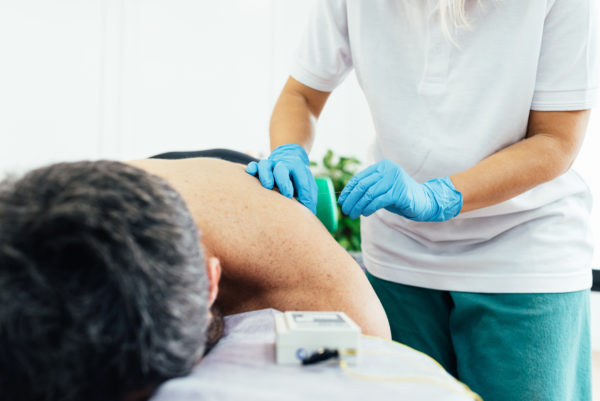
Dry needling is a technique physical therapists can use to treat myofascial pain. The technique uses a “dry” needle, one without medication or injection, inserted through the skin into areas of the muscle, known as trigger points. It helps to reduce pain, improve flexibility, and restore normalized movement when combined with corrective exercises.
In addition, dry needling is NOT acupuncture. Dry needling requires extensive training and can only be done by trained clinicians. Our therapists undergo additional training to receive their Trigger Point Dry Needling certification
WHAT IS A TRIGGER POINT?
A trigger point is a taut band of muscle fibers within a a muscle—often referred to as a “knot”. These taut bands are essentially overactive tissue that are in a constant state of contraction. Trigger points are usually tender to pressure, and may cause pain locally or refer to other areas of the body.
Dry needling techniques release these painful trigger points by causing a chemical reaction to take place between the painful tissue the nerves around it. This allows for the muscle to relax as endorphins are released and pain is reduced.
WHAT TYPE OF PROBLEMS CAN BE TREATED?
There are many conditions that can be treated with dry needling. In fact, many pain areas or dysfunctions being caused by a trigger point could be improved from dry needling. For example, some of the most common areas that we dry needle are: the upper back/neck area, glutes and piriformis, and forearms/elbow area.
WHY DRY NEEDLING?
Physical therapists use dry needling with the goal of releasing or deactivating trigger points to relieve pain or improve range of motion. This can help speed up the patient’s recovery and active rehabilitation. In fact, dry needling is widely seen as an alternative to invasive procedures and/or medications used to reduce pain.
IS IT PAINFUL?
The fine filament needle is very thin and flexible, which allows for the needle to be pushed through the skin versus cutting into the skin. This allows for the insertion of the needle to be virtually painless. When the needle comes in contact with a pathological tissue a local twitch response may be elicited. This is normal and only lasts a few seconds.
Most people experience immediate relief of their symptoms, however soreness is a common response from the needling. The soreness, if present, will usually only last 1-2 days. Stretching, movement, and light massage will help manage the soreness.
Offered in Burke, Herndon, Lorton, Old Town, Skyline, Tysons, Leesburg, Oakton and Worldgate.
For more information on Dry Needling, check out the this Mayo Clinic article









